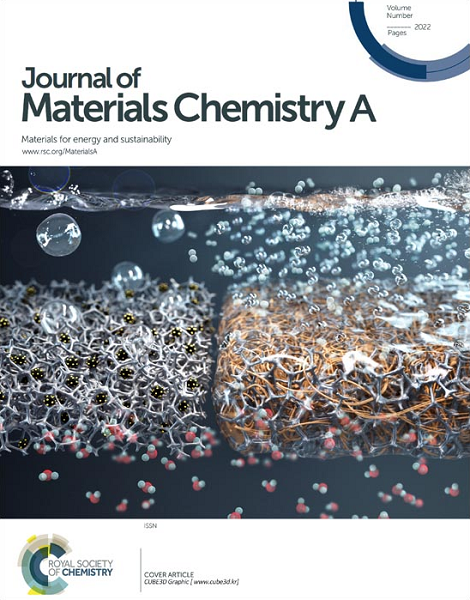在浓水蒸汽中合成的热稳定的质子传导氧氢氧化物
IF 10.7
2区 材料科学
Q1 CHEMISTRY, PHYSICAL
引用次数: 0
摘要
氧-氢氧化物的多种功能,如过渡金属氧-氢氧化物在析氧反应(OER)中的电催化活性和层状双氢氧化物(LDHs)的离子交换能力,继续引起人们的极大兴趣。然而,这些化合物通常是在室温、水热条件下或在温和的蒸汽气氛下在水溶液中合成的。在这里,我们提出了一种新的(氧-)氢氧化物合成技术,称为“蒸汽氢氧化”,它是在高温下高浓度的水蒸气大气中进行的。结构分析表明,形成了一种新的氢氧化物[ba2o (OH)y]0.55InO2,具有不匹配层状结构,其特征是不匹配的氢氧化钡双层和氧化铟块交替存在。与已知的(氧-)氢氧化物不同,这种氢氧化物表现出优异的热稳定性,在其晶体结构中保持氢氧离子高达约700°C。这些特征表明高温质子电导率的潜力很大,在500°C时,即使在干氩气下,电导率也达到5 × 10−4 S cm−1。因此,我们的“蒸汽氢化”方法为开发具有非常规化学和电子特性的质子功能材料开辟了新的途径。本文章由计算机程序翻译,如有差异,请以英文原文为准。

Thermally stable proton-conducting oxy-hydroxides synthesized in concentrated water vapor
The diverse functionalities of (oxy-)hydroxides, such as electrocatalytic activity of transition-metal oxy-hydroxides in the oxygen evolution reaction (OER) and ion exchange capabilities of layered double hydroxides (LDHs), continue to attract significant interest. However, these compounds are typically synthesized in aqueous solutions at room temperature, under hydrothermal conditions, or in mild vapor atmospheres. Here, we present a novel (oxy-)hydroxide synthesis technique called “vapor hydroxidation,” which is conducted in a highly concentrated water vapor atmosphere at elevated temperatures. Structural analysis revealed the formation of a new oxy-hydroxide, [Ba2Ox(OH)y]0.55InO2, with a misfit-layered structure, characterized by alternating incommensurate barium hydroxide bilayers and indium oxide blocks. Unlike known (oxy-)hydroxides, this oxy-hydroxide displays exceptional thermal stability, retaining hydroxide ions within its crystal structure up to approximately 700 °C. These features suggest promising potential for high-temperature proton conductivity, as demonstrated by an electrical conductivity of 5 × 10−4 S cm−1 at 500 °C even under dry argon. Our “vapor hydroxidation” method thus opens up a new avenue for the development of proton-functional materials with unconventional chemical and electronic characteristics.
求助全文
通过发布文献求助,成功后即可免费获取论文全文。
去求助
来源期刊

Journal of Materials Chemistry A
CHEMISTRY, PHYSICAL-ENERGY & FUELS
CiteScore
19.50
自引率
5.00%
发文量
1892
审稿时长
1.5 months
期刊介绍:
The Journal of Materials Chemistry A, B & C covers a wide range of high-quality studies in the field of materials chemistry, with each section focusing on specific applications of the materials studied. Journal of Materials Chemistry A emphasizes applications in energy and sustainability, including topics such as artificial photosynthesis, batteries, and fuel cells. Journal of Materials Chemistry B focuses on applications in biology and medicine, while Journal of Materials Chemistry C covers applications in optical, magnetic, and electronic devices. Example topic areas within the scope of Journal of Materials Chemistry A include catalysis, green/sustainable materials, sensors, and water treatment, among others.
 求助内容:
求助内容: 应助结果提醒方式:
应助结果提醒方式:


